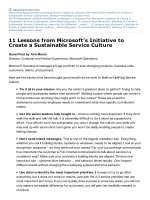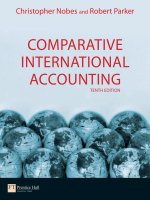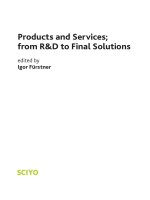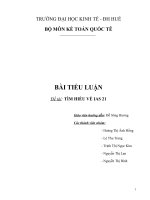International accounting standards from UK standars to IAS
Bạn đang xem bản rút gọn của tài liệu. Xem và tải ngay bản đầy đủ của tài liệu tại đây (1.27 MB, 289 trang )
International Accounting Standards
From UK standards to IAS – an accelerated
route to understanding the key principles
Paul Rodgers
AMSTERDAM • BOSTON • HEIDELBERG • LONDON
NEW YORK • OXFORD • PARIS • SAN DIEGO
SAN FRANCISCO • SINGAPORE • SYDNEY • TOKYO
CIMA Publishing is an imprint of Elsevier
CIMA Publishing is an imprint of Elsevier
Linacre House, Jordan Hill, Oxford OX2 8DP, UK
30 Corporate Drive, Suite 400, Burlington, MA 01803, USA
First edition 2007
Copyright © 2007 Elsevier Ltd. All rights reserved
No part of this publication may be reproduced, stored in a retrieval system
or transmitted in any form or by any means electronic, mechanical, photocopying,
recording or otherwise without the prior written permission of the publisher
Permissions may be sought directly from Elsevier’s Science & Technology Rights
Department in Oxford, UK: phone (+44) (0) 1865 843830; fax (+44) (0) 1865 853333;
e-mail: Alternatively you can submit your request online
by visiting the Elsevier web site at and
selecting Obtaining permission to use Elsevier material
Notice
No responsibility is assumed by the publisher for any injury and/or damage to persons
or property as a matter of products liability, negligence or otherwise, or from any use
or operation of any methods, products, instructions or ideas contained in the material
herein.
British Library Cataloguing in Publication Data
A catalogue record for this book is available from the British Library
978 0 7506 8203 9
For information on all CIMA publications
visit our website at books.elsevier.com
Typeset by Integra Software Services Pvt. Ltd, Pondicherry, India
www.integra-india.com
Printed and bound in Great Britain
07
08
09
10
10
9
8
7
6
5
4
3
2
1
Working together to grow
libraries in developing countries
www.elsevier.com | www.bookaid.org | www.sabre.org
Nothing is to be feared. It is only to be understood.
Marie Curie (1867–1934)
This page intentionally left blank
Contents
Introduction
xi
1
Harmonization – The Story So Far
1
A long winding road
2005 – The year when the accounting world would
change forever
The EU was not alone
Convergence with US GAAP
Finance directors beware
Let us not lose sight of the benefits
Key Facts
3
4
5
11
Which UK companies have had to make the
transition to IFRS?
The small company conundrum
First-time adoption: The basics
Key Facts
13
15
17
20
The Conceptual Framework
21
The Christmas tree approach
Key Facts
23
26
Presentation – The Big Picture
27
What to expect in financial statements prepared
under IFRS
Key Facts
29
30
Presentation – The Balance Sheet
31
Setting expectations
Illustrations
Key differences
Analytical consequences
Main sources of guidance
Key Facts
33
34
38
40
40
40
�
3
The Mechanics of Transition
Contents
2
5
7
7
8
9
9
v
6
Contents
7
�
vi
8
9
Presentation – The Performance Statement
41
Setting expectations
Illustrations
Key differences
Dealing with the unusual
Discontinued operations
Analytical consequences
Main sources of guidance
Key Facts
43
43
45
46
47
54
56
56
Presentation – The Cash Flow Statement
57
Setting expectations
Illustrations
What is cash?
Cash flow classification
Is a cash flow statement always required?
Treasury management
Main sources of guidance
Key Facts
59
59
62
63
64
64
68
68
Presentation – Other Primary Statements
and Associated Disclosures
71
Setting expectations
Illustrations
A closer look at UK GAAP
Key differences
The historic costs note
Main sources of guidance
Key Facts
73
74
76
78
79
80
81
Presentation – Related Parties and
Segmental Disclosures
83
Setting expectations
Related party definitions
Materiality
Related party disclosures
The scope of segmental reporting
What is a segment?
Segmental disclosures
Illustrations of segmental reporting
85
85
87
88
90
91
94
96
The future
Main sources of guidance
Key Facts
10
Tangible Non-current Assets
Setting expectations
Depreciation
Revaluation
Capitalization of borrowing costs
Government grants
Investment properties
Main sources of guidance
Key Facts
11
Intangible Assets
Asset Impairment
Setting expectations
Grouping assets and impairment allocation
Value in use – discount rates
Value in use – look-back tests
Reversal of impairment
Main sources of guidance
Key Facts
13
Leasing
Setting expectations
Determining lease classification
Land and building issues
Operating lease disclosures
Allocation of finance costs
Main sources of guidance
Key Facts
113
113
114
116
117
118
122
122
123
125
125
129
130
132
135
136
137
139
140
141
142
142
142
143
145
147
150
151
151
153
153
154
�
12
111
Contents
Setting expectations
Goodwill
Other intangibles
Research and development
Illustration of IAS GAAP
Main sources of guidance
Key Facts
109
109
109
vii
14
Stock and Long-term Contracts
Setting expectations
What’s in a name?
Reduced disclosure
Main sources of guidance
Key Facts
15
Taxation
Contents
Setting expectations
FRS 19 snapshot
IAS 12 – Temporary differences instead of timing
differences
Discounting
Intragroup transactions
Deferred tax assets
Disclosure
Main sources of guidance
Key Facts
16
Retirement Benefits
�
Setting expectations
Accounting for actuarial gains and losses
Valuing scheme assets
Presentation
IAS 19 – A broader emit
Main sources of guidance
Key Facts
viii
17
18
155
157
157
158
159
159
161
163
163
164
165
166
166
167
168
168
171
173
175
179
180
180
181
181
Revenue Recognition
183
Setting expectations
IAS 18 – a brief synopsis
Main sources of guidance
Key Facts
185
185
186
186
Group Accounts – Acquisition Accounting
Setting expectations
What is a subsidiary?
Exemptions from the requirement to produce group
accounts
Excluded subsidiaries
Non-coterminous year ends
187
189
189
190
191
192
Special purpose entities
Distributions out of pre-acquisition profits
Disclosure
Do not forget those goodwill differences
Main sources of guidance
Key Facts
19
Group Accounts – Associates
Setting expectations
Defining an associated undertaking
The use of equity accounting
The cost method
Consequences of a poorly performing associate
Presentation
Main sources of guidance
Key Facts
Group Accounts – Joint Ventures
21
Group Accounts – Merger Accounting: The
End of the Road
Setting expectations
When can merger accounting be used in
the UK?
Key differences compared to acquisition
accounting
Main sources of guidance
Key Facts
22
Narrowing the Divide – UK GAAP Goes
International
Setting expectations
Share-based payment
Events after the balance-sheet date
Earnings per share
Foreign currency translation
203
203
203
204
205
205
208
209
211
213
214
217
218
218
219
221
221
222
223
223
225
227
228
232
235
237
�
Setting expectations
Accounting for a joint venture
Déjà vu
Main sources of guidance
Key Facts
201
Contents
20
193
193
194
198
199
199
ix
Hyperinflationary economies
Financial instruments
Main sources of guidance
Key Facts
23
Flicking the Switch: First-time Adoption
Setting expectations
Additional disclosures
Exemptions
Main sources of guidance
Key facts
Contents
Index
�
x
241
241
249
250
253
255
255
264
265
265
267
Introduction
The World never stands still and the same is true of the business
community and the people that comprise it. Business organizations
strive to improve their profits, borrow to fund growth or sell assets
to facilitate survival, but the one thing they can never do is stand
still or at least not for very long.
Furthermore the commercial universe comprises not of a meagre
handful of business entities but millions ranging in size from the
sole trader to the international conglomerate. If all of these factors
are combined there appears to be a recipe for chaos, but this is not
the case. As the number and complexity of business organizations
has increased so have the rules and guidelines that constrain them.
Let us focus on the larger corporations as these will be represented
by household names with which we can all associate. These usually
have a large and diverse investor base plus interactions with many
other stakeholder groups ranging from suppliers/customers to gov
ernment. The most readily available source of information on the
business for all these user groups is the published financial state
ments, and it should come as no surprise that these have evolved
from a simple historic record of transactions as seen 50 years ago
to the detailed multi-part document seen today. Since the 1990s the
evolution of financial statements has had three main strands.
1. Corporate governance There is a general principle that the man
agement team of a company will enter into transactions that are in
the best interests of the shareholders and other stakeholder groups.
�
� Corporate legislation
� Industry guidelines
� Listing requirements and other stock exchange rules for public
companies
� Accounting standards.
Introduction
The balance between these two forces is always a matter for debate
with some commentators stating that the entrepreneurial spirit
of business is being crushed by red tape, whilst others look for
increased controls following a series of high profile corporate frauds
such as WorldCom which required a $74.4 billion restatement of
income. These rules come from many sources:
xi
Sadly the confidence of these stakeholders has been undermined by
a series of high profile frauds and it was one of these, namely the
financial mismanagement at the Enron Corporation, which initiated
a groundswell for improved corporate governance.
The concept of corporate governance asks ‘how well the managers
manage’, and has seen a tidal wave of new legislation and best
practice rules instigated in all the major investment markets around
the World. Most noteworthy of these has been the Sarbannes–Oxley
Act in the USA and the Combined Code in the UK.
Introduction
Disclosures relating to corporate governance and the audit of its
compliance are now an integral feature of published accounts.
�
xii
2. Social and environmental reporting Unlike corporate gover
nance the majority of the rules on reporting how a business interacts
with the environment are voluntary, but with increasing awareness
of issues such as global warming and sustainability of resources this
looks set to change.
The absence of statute initially created the danger that only those
organizations that were perceived as environmentally aware would
provide stakeholders with details of their policies. However, this is
rapidly changing as it becomes apparent that socially aware poli
cies can improve brand perception and hence add to shareholder
value.
3. International harmonization With the development of the Inter
net, increased ease of international travel and the development of
companies through international growth and acquisition, the days
when an investor would usually be based in the same country as the
business in which they had invested have passed. This brings huge
opportunities but also creates a dilemma for a potential investor try
ing to appraise the relative merits of expanding their portfolio into
new markets.
The accounting rules and conventions of different countries have
been developed when little regard was needed for international con
sistency. This insular approach has now been found wanting on
the global stage, and so the wheels were set in motion towards the
harmonization of these divergent rules.
Of all the changes identified above it is the latter that has proved
the most daunting with a natural instinct for the creators of national
accounting rules to advocate their own work, and the logistics of
changing local legislation.
However, the drive to harmonize accounting is often perceived as
a technical exercise that will occupy the brains of accounting aca
demics but have little real bearing on the average stakeholder. Hope
fully the fact that you have picked up this book means that you are
aware this is not the case, but if you have any lingering doubts let
us take a snapshot of the evidence.
BUT
Fear not!
There is a sensible compromise between blissful ignorance and the
finely tailored skills of a public company finance director – think
what you really need.
To understand the key
differences between
UK accounting
standards and their
international
equivalents
To know the
differences in
terminology and
layout
To appreciate the
consequences for
financial indicators
and the decisionmaking process
�
At this point you might be sensing a degree of trepidation envisaging
the stacks of paperwork you need to read bulging with the technical
jargon of accountants.
Introduction
� Although harmonization is initially focussed on listed companies
it has implications for businesses of every size either directly or
indirectly through trading relationships.
� The reported performance and position of a business can be dra
matically altered by the change to new accounting rules. Without
an understanding of the main issues, investment appraisal could
be seriously undermined.
� Providers of finance will need to review financial covenants
included in funding agreements as the thresholds set may no
longer be appropriate.
xiii
Introduction
The objective of this book is to provide a succinct and straightfor
ward route map to meeting these needs. It will allow you to pick and
choose subjects of particular interest or taken in aggregate provide
a direct path to a big picture understanding of the consequences of
the switch to international accounting – let us get to work!
�
xiv
1
Harmonization – The Story
So Far
This page intentionally left blank
A long winding road
Our priority is to understand the impact of the transition from
UK to current international accounting rules on company finan
cial statements, but this will be easier if we have an overview of
the sequence of events that brought us to the brink of this groundbreaking transition.
1973
International Accounting Standards Committee (IASC)
formed comprising 16 representative bodies from nine
countries.
1977
The first International Accounting Standard (IAS) is
issued looking at inflation accounting.
As new IASs were developed and released
the emphasis of the IASC was to increase
their acceptance by persuading listed
companies to adopt them ‘in addition’ to
their national accounting rules.
This was possible as some of the early
IASs were phrased to allow some
flexibility.
1981
International consultative group formed to allow greater
input from preparers of financial statements, stock
exchanges, etc.
1989
International Organisation of Securities Commissions
(IOSCO) observed that cross-border activity would be
aided by internationally accepted accounting standards.
�
The Accountants International Study Group instigated by
Lord Benson was established to look at accounting and
auditing harmonization. It comprised representatives from
the UK, US and Canada.
Harmonization – The Story So Far
1967
3
1994
IOSCO reviewed existing international standards and
identified changes it considered necessary before it would
recommend their use in cross-border transactions.
International Accounting Standards
By the early 1990s a change of emphasis
had emerged from the IASC. With a
significant number of standards now in
issue they looked to:
• Strengthen existing standards
• Fill noteworthy gaps
• Try to eliminate inconsistencies
with national rules
This was now given added impetus to meet
the demands of IOSCO.
Advisory Council formed comprising of leading figures
from varied backgrounds to act as a sounding board for
IASC decisions.
1997
Standings Interpretation Committee (SIC) formed to allow
a rapid review of contentious areas or divergent views.
�
1995
4
1999
The improvements and additional standards required by
IOSCO were completed and put forward for its review.
Although, not the original intention, IOSCO acceptance
was now focussed on gaining acceptance from the US
Securities and Exchange Commission (SEC).
Many other leading exchanges including those of the
European Union had already indicated their acceptance
of using IAS for cross-border listings without requiring a
reconciliation to national GAAP (Generally Accepted
Accounting Practice). It was the need for such a
reconciliation that created one of the greatest barriers
to change because of the additional work it required
from the preparers of financial information.
2000
A low point for the IASC – IOSCO completed their review
of 30 IASs and whilst recommending their use by IOSCO
members included a significant caveat.
IOSCO members would be allowed to mandate any of the
following ‘supplemental treatments’:
• Reconciliation to national GAAP
• Additional interpretation.
2001
Trustees appointed to the IASC Foundation – a new body
that would head the ‘rebirth’ of the international accounting
infrastructure.
The new Chairman of the IASB was Sir David Tweedie
who had previously chaired the UK Accounting Standards
Board (ASB).
�
As new international standards were
released they were rebadged as IFRSs
(International Financial Reporting
Standards). This means that there is
currently a mixture of IASs and IFRSs in
issue, but they have the same status.
Harmonization – The Story So Far
The International Accounting Standards Board (IASB)
assumed standard-setting responsibilities from the IASC and
the SIC became the International Financial Reporting
Interpretations Committee (IFRIC).
5
2001
IASB announced an Improvements Project looking at
existing standards with the aim of improving their quality
and consistency.
2004
Improvements Project completed.
2005 – The year when the accounting
world would change forever
The member states of the European Union (EU) each have a rich
social and economic history, and this extends to the development of
national accounting best practice. However, this independent evolu
tion creates challenges to the EU when trying to balance the retention
of individual identity with the development of a single market that
both encourages and reduces the costs of international trade between
members.
The most common mechanism for creating uniformity has been the
issue of Directives, which require member states to modify their
national legislation to ensure compliance. This concept will be very
familiar to accountants in the UK who have been effectively required
to follow the EU Fourth and Seventh Directives.
Fourth Directive
International Accounting Standards
Seventh Directive
�
6
Prescribes financial statement formats, note
disclosures and provides rules on valuation
Prescribes rules for the preparation of con
solidated financial statements
Some aspects of these Directives were undoubtedly compromises.
This was not ideal but necessary to bridge some core conceptual
differences between member states, the most noteworthy of which
was the very purpose for which financial information was being
created.
United
Kingdom
Shareholders are perceived
as the most important
stakeholder in the receipt
of financial information as
historically they had been
the biggest provider of
finance
Germany
Financial statements
are prepared for the
tax authorities,
and consequently
the calculation of
taxable profit
The EU recognized that, with aspirations to increase the number of
member states, a more robust and comprehensive accounting legis
lation was required, and in 1995 acknowledged that closer liaison
with the IASC and IOSCO was required to achieve this objective –
the wheels of change had been set in motion albeit slowly.
It was not until 2000 that the European Commission announced pro
posals for all listed EU companies to produce financial statements
complying with IAS by 2005. Suddenly the pace of change quick
ened with changes being made to the Fourth and Seventh Directives
to avoid conflict with international accounting rules and in July
2002 the requirement for the adoption of international accounting
rules became EU policy.
This decision set in motion a cascade of activity within the listed
companies of the EU as they prepared their staff and systems for the
changes ahead.
On 1 January 2007 Romania and Bulgaria increased the constituency
of the EU to 27 member states, and with the prospect of further
enlargement still to come the EU represents the showcase through
which the IASB can bring international accounting to the forefront
of the financial world.
The IASB continues to work actively towards the global acceptance
of its accounting standards with approximately 100 countries indi
cating an intention to adopt IFRS or alter their national GAAP to
make it compliant at the date of publication.
However, as with any transition of this magnitude the time scale
and details of implementation differ markedly.
Harmonization – The Story So Far
The EU was not alone
The spectrum of IFRS compliance as at January 2007
�
7
E.g.
Ghana &
Pakistan
IFRS not
permitted
E.g.
Bermuda &
Gibraltar
IFRS
permitted
E.g.
Peru & South Africa
IFRS
required
Convergence with US GAAP
Although the decision by IOSCO in 2000 not to give unqualified
acceptance of IAS allowed the US SEC to require companies listing
on a US exchange to provide a reconciliation with US GAAP this
did not represent an accounting isolationist policy. This was con
firmed in 2002 by the signing of the Norwalk Agreement between
the IASB and the US Financial Accounting Standards Board (FASB),
specifying an intention to work together in the development of
accounting standards that facilitated the harmonization of US and
international GAAP.
International Accounting Standards
Immediate steps were taken to eliminate discrepancies where agree
ment was easily obtained, and a longer term but practical approach
adopted to areas of greater disparity. This process is ongoing and
may take until the end of Sir David Tweedie’s second term as Chair
man of the IASB (i.e. 2011).
Sadly this means that the necessity for non-US companies listing on
the New York Stock Exchange or NASDAQ to prepare a reconcilia
tion of profit and equity from IFRS to US GAAP remains.
Finance directors beware
Place yourself in the position of a finance director of a UK listed
company, and consider how the business you represent interacts
with the business world that surrounds it. The volume of change,
both commercial and legislative, is staggering (Figure 1.1):
�
8
From December 2004 the
company audit to be
undertaken in accordance
with international auditing
standards
An ongoing
Company Law
Review
Adoption of
international GAAP
Financial statements now
available to stakeholders
anywhere in the World via
the Internet
Figure 1.1 The changing world of business
Change is inevitable but occasionally there is a need to pause for
breath otherwise there is a danger of focus moving disproportion
ately from business success to compliance and this is not in the best
interests of any stakeholder group. The IASB have recognized this
and in 2006 steps were taken to achieve this objective.
� One year will be allowed between the date of publication of a
wholly new IFRS or major amendment to existing IFRSs and the
date when implementation is required.
� No new standards to be effective before 2008, and in line with
this move the application of new IFRSs under development will
not require implementation until 1 January 2009.
The true benefits are longer term, but this does not make them any
less desirable.
1. Increased disclosures will improve the transparency of financial
statements.
2. Comparability remains the biggest benefit in a global market, and
it will only be when the harmonization process is completed with
the US that the ultimate prize will be reached.
3. The ability of a company to communicate with all stakeholder
groups will be improved.
4. The cost of capital will fall and market liquidity improve.
Key Facts
1. Global harmonization of accounting best practice has been evolv
ing since the 1960s but has seen a sharp acceleration as we enter
the 21st century.
2. The International Accounting Standards Board is the leading
organization in the harmonization process.
�
There is always resistance to change and numerous commentators
have observed that they do not believe the cost of transition to IFRS
is offset by measurable benefits. It is certainly true that the cost of
computer infrastructure and the marginal cost of key staff has been
high, particularly in financial institutions. Additionally the financial
position and performance of companies immediately post-transition
has not been one of consistent improvement or deterioration, but has
been heavily dependent on which accounting standards are most
significant to a particular business.
Harmonization – The Story So Far
Let us not lose sight of the benefits
9
International Accounting Standards
�
10
3. The US remains the largest financial market resistant to the
recognition of IFRS, but following the 2002 Norwalk Agreement
the IASB and their US equivalent, the FASB, are working together
towards a long-term solution.
4. EU listed companies producing group financial statements must
adopt international GAAP from 2005 (for more on this, see
Chapter 2).
5. Large companies have been faced with an ever-increasing wave
of change extending beyond the requirements of the IASB to com
pany law and audit regulations. The IASB has recognized the
need for a breathing space so that systems can be implemented
and stakeholders given the opportunity to familiarize themselves
with the changes.
6. The long-term benefits of global harmonization of accounting
practice are immense – it is very much a case of short-term pain
for long-term gain.









